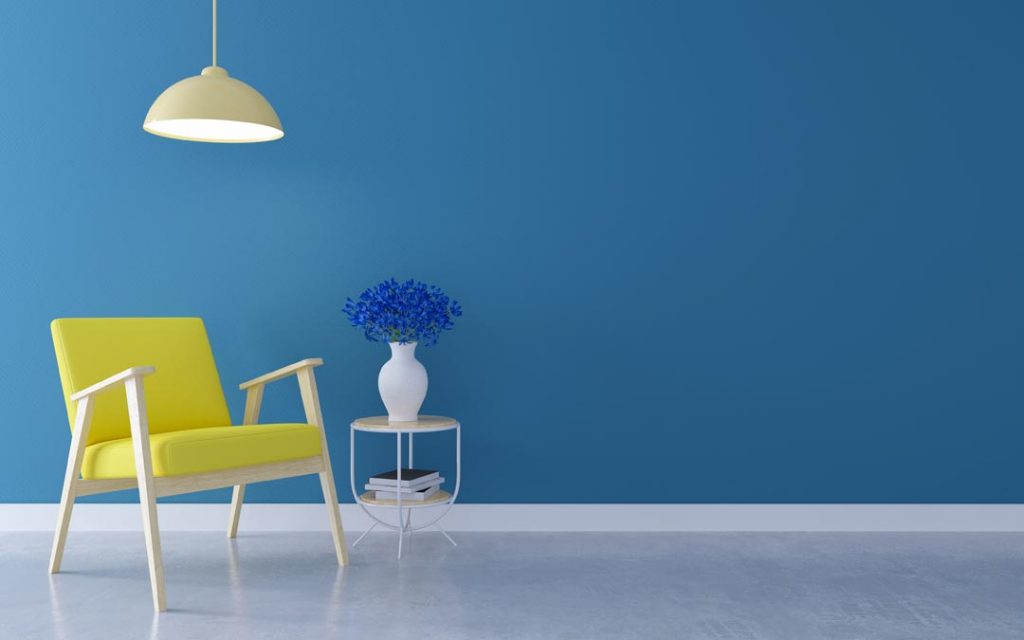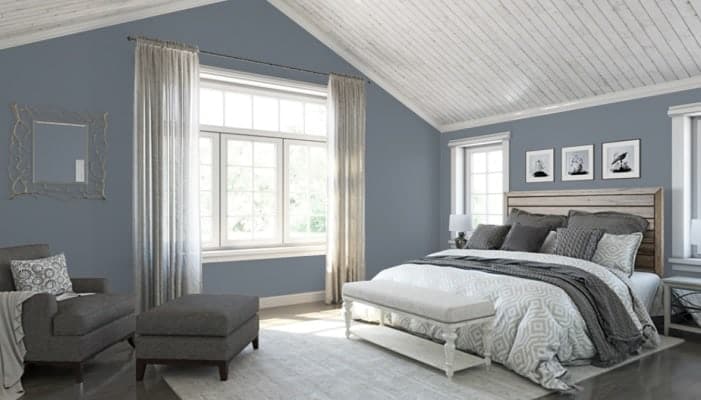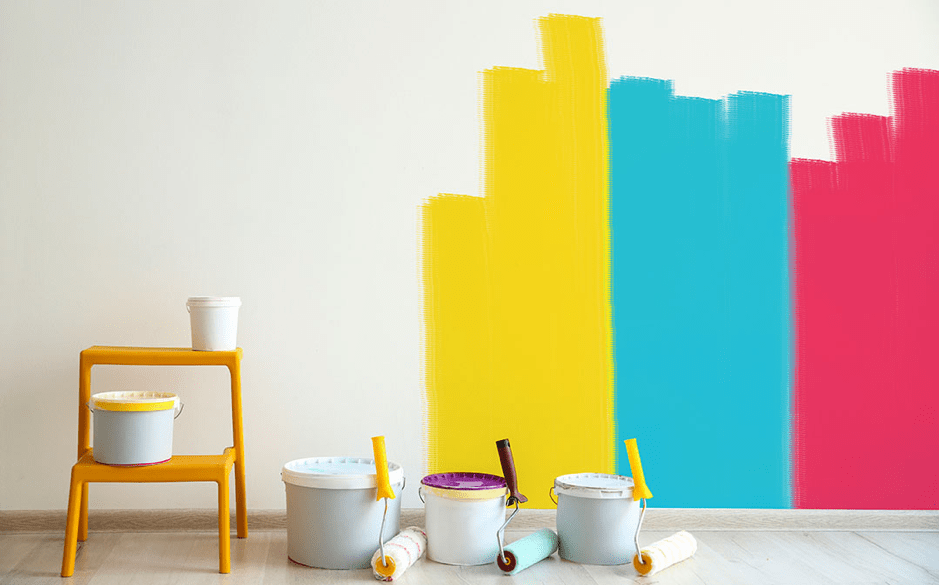When you want to select paint colours for your home, it is similar to choosing your wardrobe. You may like one colour more than the others, but you wouldn’t wear them all at once. The same is true when you want to select paint colours.
In the process of interior house painting plans and choosing colours for your house, it’s helpful to start with the essentials.
A historic home with dark chocolate trim and wainscoting may clash with an ice-chilly paint colour on the walls. When using colour to create a unified aesthetic in a home, the most important consideration to remember is to maintain consistency and choose comparable undertones.

Tips to Help You Select Paint Colours:
Begin to select paint colours with the location of your residence. When starting a house, condo or apartment painting project, search for colour cues in the surrounding area. Most colour schemes and some nature-inspired colours may be made to work by a skilled designer.
However, certain options may be more suited to a given property than others. For example, the contrast between moody interior paint colours and the ambience of a seaside home may be difficult to carry off.
Amplify the paint colour you love
You don’t have to start from scratch when you select paint colours for your home. If you already have a set of favourite colours you adore but are seeking a complementary shade, select paint colours with the same undertone; they will coordinate flawlessly.
For example, if you want to complement an existing blue accent wall with a red undertone, use any neutral with a red undertone; they would look excellent together.
Select paint colours of the same tone: cool or warm
The setting of the property, as well as existing room design and furniture, typically impact whether a cool-tone or warm-tone palette is chosen. Once you’ve selected paint colours that work best for you, stick with them.
Use neutrals to your advantage
It’s like rooms talking to one other, and the best neutral paint colours can facilitate the dialogue. For example, a neutral colour on the doors and trims all over the property can help link the sections.
You may also select neutral paint colours as a “palette cleanser” on the walls of a room adjacent to another room with brighter colours.

Find a favourite white paint
Every house has some white in it. Once you’ve decided on a white, you should stick with it throughout the house. After establishing a solid foundation, you may select paint colours. Some whites aren’t very bright and don’t read blue.
They are a little bit warmer than an extra white. These colours are inviting and provide a clean appearance.
Select paint colours that’ll layer the colour room to room
You don’t have to stick to a single colour, even in a shared area. When you have connected rooms and want to create a lovely flow, select paint colours which is a few degrees lighter or darker within the same colour family and tones.
It is easy on the eyes when you move from one room to the next.
When you want to select paint colours, don’t get boxed in by one colour
Inviting a fresh colour into your home may add much-needed depth. Part of the pleasure in design is not restricting oneself to a limited box. You can enjoy a house with a room or two with a wonderful vivid colour contrasting with the rest of the house.
When the wall paint transitions smoothly, the peekaboo moment creates a delightful surprise. We suggest confining this impact to a dining room or a study to prevent a colour clash that appears overly cluttered.
Select paint colours considering the trim
When you select paint colours, avoid factory-white windows because the ultra-stark colour might produce dissonance, especially when contrasted with warmer off-white window trim. While only sometimes the case, some people like to have the trim and mullions the same colour, which provides a coherent sense.
Matching the trim to the wall colour also aids the transition, especially when using high-quality paint. Using the same colour on all the trim and doors is a consistent architectural feature that unifies the entire home’s look.

Select paint colours that will provide some wiggle room
Even if you have a dream colour palette in mind, the realities of your home may prevent you from going all out. Assume your child is fascinated with pink, but you want something other than a Barbie bedroom.
But even though hot pink is popular, you can still make a compromise that works with the rest of the house’s colour scheme. To please parents and children, we recommend painting an area that is not all four walls, such as the ceiling.
A nursery can be decorated in dusty, hot pink. Not only would the colour be concealed from view through the doorway, but it would be delightful for children to look up from their beds and witness their vision come to life.
Alternatively, you may conceal the kid-pleasing colour in a bathroom by colouring vanity cabinets or adding a fun colour band.
Match the colour to the room feeling you like in the room
Colours provoke emotional responses. Cool colours (blues, greens, and pure whites) are peaceful and relaxing, whereas warm colours (red, orange, and yellow) produce drama and intensity.
Cool colours, such as walls painted with ice blue in the bathroom, are peaceful in private areas; warm colours are a terrific way to liven up social settings.
Colour psychology is a minor curiosity among paint specialists. Many people believe that you should select a colour depending on how a space is utilized and the vibe you wish to create.
We recommend painting communal rooms (kitchens, dining rooms, family and living areas) in warm colours such as daffodil-yellow, coral, or cranberry, and private rooms (home offices, powder rooms, bedrooms) in cooler colours such as sage-green, violet, or sky-blue.
Remember that when it involves emotional impact, one person’s welcome-home orange may be another person’s signal to leave the place quickly.
In general, some designers believe that red will raise your appetite—and your blood pressure; blues and greens are natural and peaceful; purple is appreciated by youngsters but not often by adults; yellow is pleasant; and orange may be both friendly and aggravating, depending on the tint, tone, or shade.
According to research, yellow may stimulate the brain, so it may be worth considering for areas where schoolwork is done; however, avoid yellow in bedrooms, where the purpose is to relax and calm your mind down. Instead, experiment with these soothing colours in your bedroom to help you sleep better.
Conclusion
This article will inspire you to liven up your home with a fresh coat of paint soon! You may choose one of the well-known methods, such as painting with rolls or brushes and the spray painting method.
And finally, as long as you anchor your home with a few core paint colours, you’ll be able to keep a unified colour scheme despite a few outliers.

